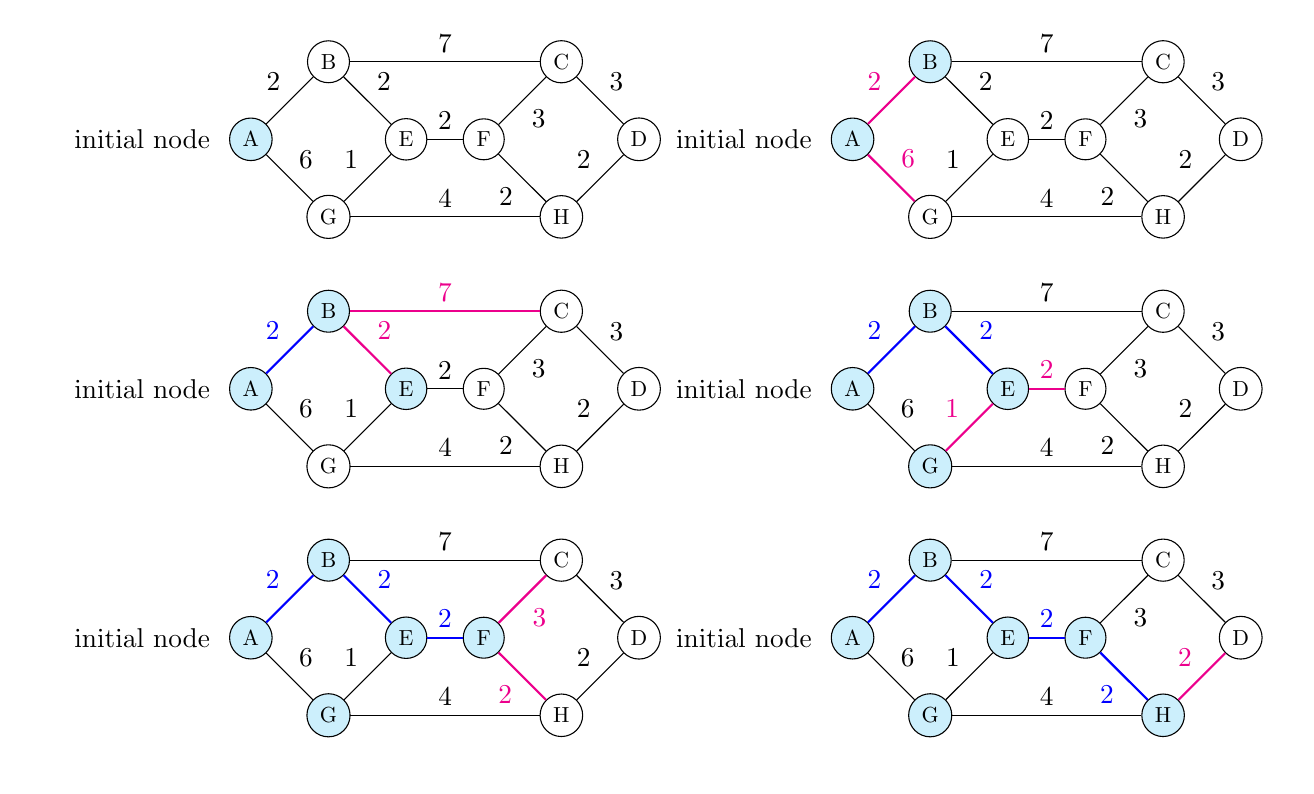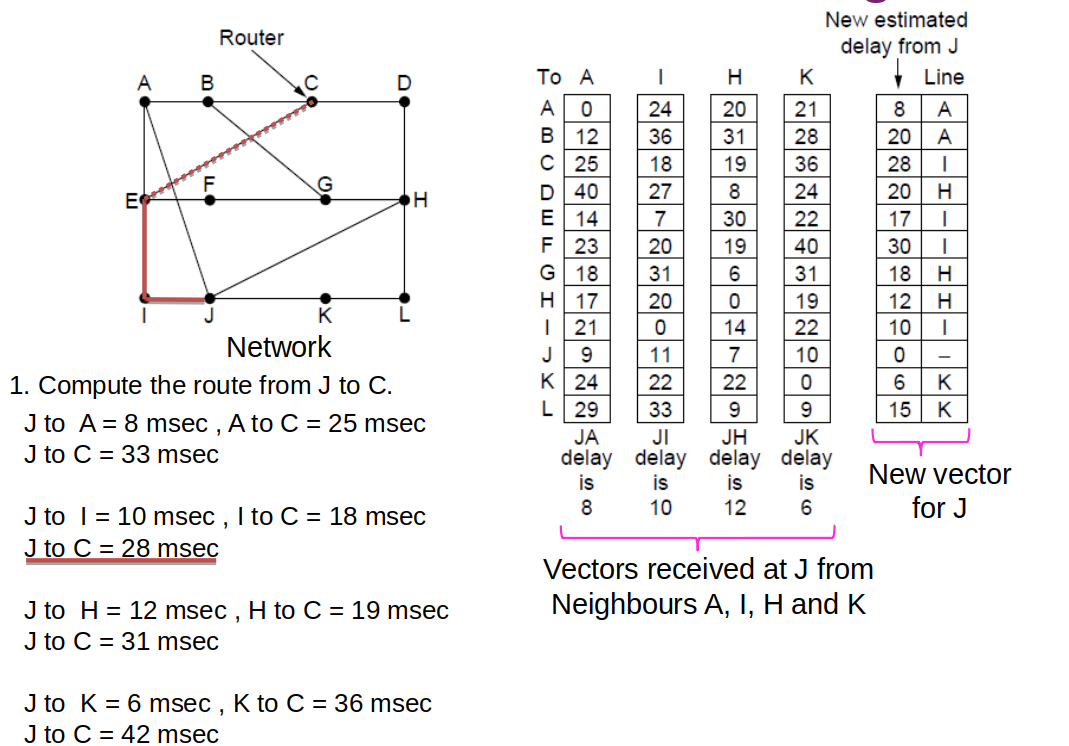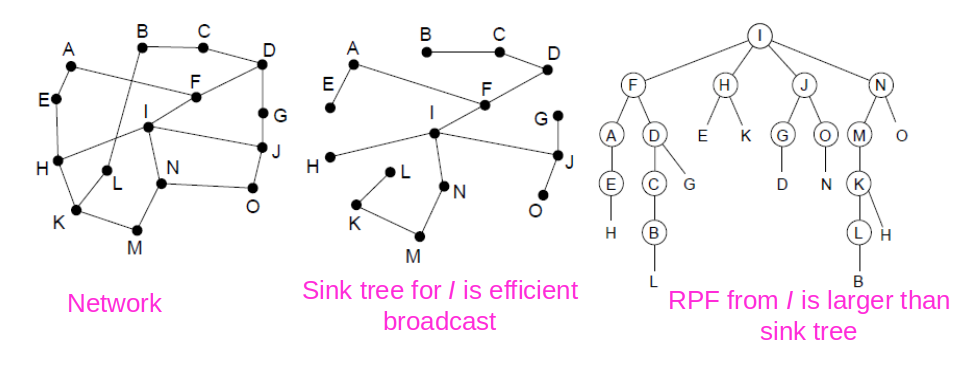Anne Reinarz Durham University
Outline
Outline
-
Routing algorithm: routing packets from source to destination.
-
Optimality principle: finding the optimal path from source to destination.
-
Various routing algorithms
- Dijsktra’s algorithm
- Dynamic routing algorithms:
- Distance vector algorithm
- Link state routing
- Hierarchical routing
Routing Algorithms
- Routing is the process of discovering network paths
- Decide what to optimize (e.g., fairness vs efficiency)
- Model the network as a graph of nodes and links
- Update routes for changes in topology (e.g., failures)
Optimality Principle
If router J is on the optimal path from I to K,
then the optimal path from J to K is on the same route
</br>
- Identify the optimal path from source to destination.
- Sink tree: optimal routes from all sources to a given destination.
- Distance metrics:
- the number of hops, or
- time delay.
Optimality Principle
 </img>
</img>
Shortest Path Algorithm
Dijkstra’s algorithm computes a sink tree on the graph:
- Each node is labelled with its distance from the source node to the best known path
- Initially no paths are known
- Each link is assigned a non-negative weight/distance
- Shortest path is the one with lowest total weight
Shortest Path Algorithm
Algorithm:
- Start with sink, set distance at other nodes to infinity
- Labels tentative (○) or permanent (⚫), initially all tentative
- Pick lowest distance non-permanent node, make perm.
- Repeat from this node, until all nodes are permanent
Shortest Path Algorithm
 </img>
</img>
- weights represent cost/distance
Shortest Path Algorithm
 </img>
</img>
- A network and first five steps in finding the shortest paths from A to D. Pink arrows show the sink tree so far
</small>
Distance Vector Routing
Two types of dynamic routing algorithm:
- Distance vector, and
- link state routing algorithms
Distance Vector Routing
Distance vector:
- Each node maintains a table (vector of best distance to dest.)
- Tables are updated by exchanging information between nodes
- Tables have 2 entries: outgoing line and estimated distance (#hops or propagation delay)
Distance Vector Routing
Algorithm:
- Each node knows distance of links to its immediate neighbours
- Each node advertises a vector of the lowest known distances to all nodes
- Each node uses received vectors to update its own
- Repeat periodically
Distance Vector Routing
 </img>
</img>
Distance Vector Routing
 </img>
</img>
Black Holes
 </img>
</img>
The Count-to-Infinity Problem
- Failures can cause DV to “count to infinity” while seeking a path to an unreachable node
 </img>
</img>
Distance Vector Routing
Link State Routing
- Learn the network address of the neighbouring routers by sending HELLO packet, record name
- Set the distance to each neighbour
- Construct a packet telling all other routers what it has just learned
- Send the packet to and receive packets from all other routers
- Compute the shortest path by using Dijkstra’s algorithm
Link State Routing: LSPs
- LSP (Link State Packet) for a node lists neighbours and weights of links to reach them
 </img>
</img>
Flooding
-
A simple method to send a packet to all network nodes
-
Each node floods a new packet received on an incoming link by sending it out on all of the other links
- Nodes need to keep track of flooded packets to stop the flood
- E.g. by using sequence numbers
- Does not rely on routing tables being built first
Hierarchical Routing
- Hierarchical routing reduces the work of route computation but may result in slightly longer paths than flat routing
 </img>
</img>
Broadcast Routing
- Broadcast sends a packet to all nodes
- RPF (Reverse Path Forwarding): Arrived packets are checked to see if they arrived from a preferred link, which is the link that is normally used for sending packets towards the source of the broadcast.
- 1st hop: I sends packets to F, H, J, and N. Packets arrive on the same link that is used to send to I
- 2nd hop: 8 packets are generated, two by each router. 5 of them arrive on the preferred link
- …
Broadcast Routing
 </img>
</img>
Summary
- Packet routing algorithms
- Different routing algorithms
- Dijsktra’s algorithm
- Shortest path algorithm
- Distance vector routing
- Link state routing
- Hierarchical routing
- Flooding
- Broadcasting